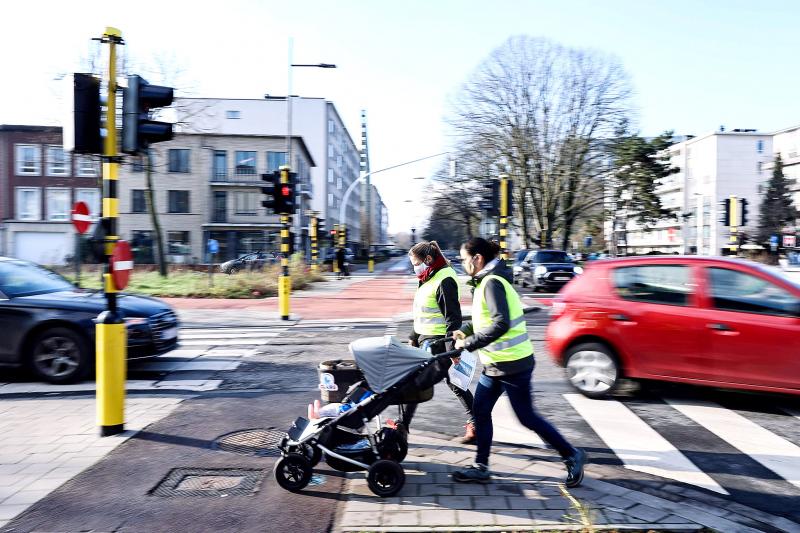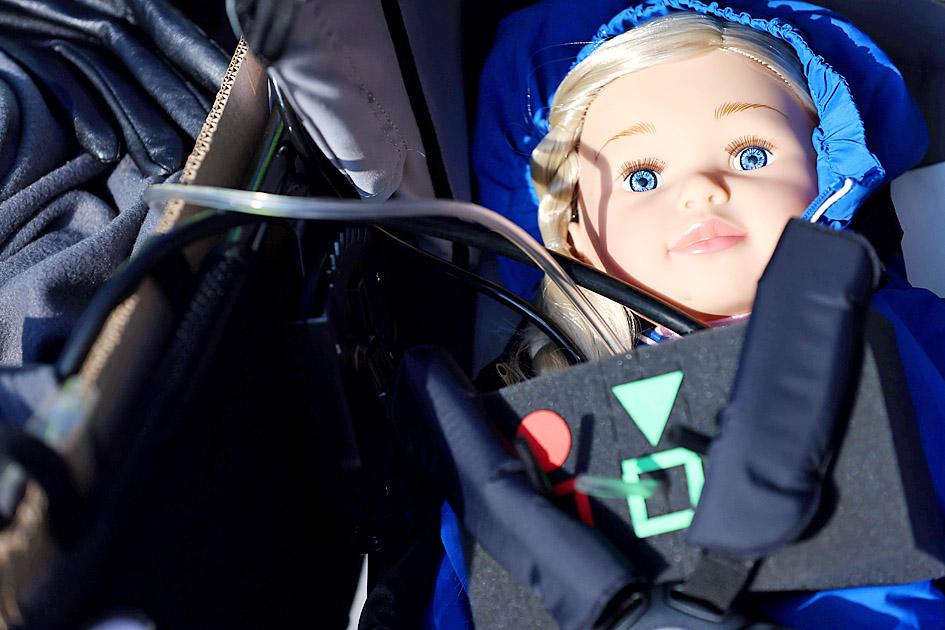Out for an afternoon hike, Veerle Bonaers and a friend stop pushing their baby and look down to their map, suddenly aware they have taken a wrong turn. Their baby, Claire, dressed in pink slippers, does not make a sound, sitting snug in her blue buggy, winter sunlight touching her soft tuft of blonde hair.
Claire, an acronym for Clean Air for Everyone, is silent because she is a doll. Wedged beside her are three electric sensors that measure the particulate matter that spews out of factories and exhausts.
Her minders, although dressed for a trek, will walk 7.5km from the University of Antwerp campus through Belgium’s notorious traffic, which makes this small EU country of 11 million one of the most harmful polluters in Europe.

Photo: AFP
Air pollution is responsible for about 7 million premature deaths worldwide each year, according to the UN.
In Europe, tens of thousands of city dwellers die prematurely every year, a study in The Lancet Planetary Health journal showed.
Among European cities, Antwerp is the second deadliest after Madrid when it comes to exposure to nitrogen dioxide, the poisonous gas emitted by diesel autos. Nitrogen dioxide is also the gas made infamous in the Dieselgate scandal that exposed mass cheating by Volkswagen, the German auto giant that used a secret device in millions of vehicles to brazenly circumvent EU pollution norms.

Photo: AFP
“I have a child myself and I’m very concerned about the effect of air pollution,” Bonaers said as her friend Mariska Hendrickx redirected their stroll, traffic cruising by on the busy Prins Boudewijnlaan.
Claire is the brainchild of Roeland Samson, a professor at the university’s Department of Bioscience Engineering, whose research ropes in Antwerp citizens to help his team more widely measure exposure to air pollution.
“We have hundreds of parents and grandparents willing to go on a walk with Claire,” the professor said as he gave the day’s walkers their instructions.
“This is very important because air quality varies a lot. If we just do one measurement in time we wouldn’t have a complete picture,” he added.
When Claire is in her buggy, traffic-related pollution such as soot and particulate matter is logged every 10 seconds. Other parameters, such as wind speed and time of day, are also recorded.
The plan is for Claire to go out daily until November, and volunteers are able to sign up on the university Web site dedicated to the project.
Antwerp is the biggest city in Flanders, Belgium’s densely populated — and flat — Dutch-speaking region, with a notorious ring road, one of the most traffic-clogged arteries of Europe.
Vehicles there share the road with a never-ending flow of container trucks that roar to the city’s massive port, the second largest in Europe.
Flanders is largely urban sprawl and most Belgians dream of a stand-alone house in suburbia, encouraging ever more construction. They also benefit from one of the world’s most generous company auto schemes, in which firms are incentivized to give their employees a vehicles and free gas instead of a raise.
The scheme, criticism by the EU and the Organisation for Economic Co-operation and Development, puts hundreds of thousands of vehicles on Belgium’s congested roads, most often gas-guzzling late models, although auto companies have started to clean up their act because of the climate crisis.
Joeri Thijs, spokesperson and senior climate campaigner at Greenpeace Belgium, said that the scheme “has pushed a lot of employees into a car even when they don’t need it for their jobs.”
Scrapping it, he said, “takes political courage obviously because it is taking away a benefit that a lot of people get and have gotten used to.”
The Belgian government has initiated a plan to fully electrify the company auto scheme away from fossil fuels, which Thijs said he hoped would get the Belgian commuter to rethink their mobility and turn to bikes, public transport or even just walking.
“Most people realize, even those sitting in the traffic jams, that we need to go for another kind of mobility,” he said.
This new awareness is pushing people to sign up to spend an afternoon with Claire. In Antwerp, where a conservative mayor has only recently made pollution a priority, several citizen-led initiatives have emerged.
In 2016, for example, 2,000 residents installed low-cost captors to better measure the dirty air.
“If people help build the data, they also better understand what is going on and they make the data their own,” Samson said. “It helps them to ... spread the word to the world.”

CHIP RACE: Three years of overbroad export controls drove foreign competitors to pursue their own AI chips, and ‘cost US taxpayers billions of dollars,’ Nvidia said China has figured out the US strategy for allowing it to buy Nvidia Corp’s H200s and is rejecting the artificial intelligence (AI) chip in favor of domestically developed semiconductors, White House AI adviser David Sacks said, citing news reports. US President Donald Trump on Monday said that he would allow shipments of Nvidia’s H200 chips to China, part of an administration effort backed by Sacks to challenge Chinese tech champions such as Huawei Technologies Co (華為) by bringing US competition to their home market. On Friday, Sacks signaled that he was uncertain about whether that approach would work. “They’re rejecting our chips,” Sacks

Taiwan’s exports soared 56 percent year-on-year to an all-time high of US$64.05 billion last month, propelled by surging global demand for artificial intelligence (AI), high-performance computing and cloud service infrastructure, the Ministry of Finance said yesterday. Department of Statistics Director-General Beatrice Tsai (蔡美娜) called the figure an unexpected upside surprise, citing a wave of technology orders from overseas customers alongside the usual year-end shopping season for technology products. Growth is likely to remain strong this month, she said, projecting a 40 percent to 45 percent expansion on an annual basis. The outperformance could prompt the Directorate-General of Budget, Accounting and

NATIONAL SECURITY: Intel’s testing of ACM tools despite US government control ‘highlights egregious gaps in US technology protection policies,’ a former official said Chipmaker Intel Corp has tested chipmaking tools this year from a toolmaker with deep roots in China and two overseas units that were targeted by US sanctions, according to two sources with direct knowledge of the matter. Intel, which fended off calls for its CEO’s resignation from US President Donald Trump in August over his alleged ties to China, got the tools from ACM Research Inc, a Fremont, California-based producer of chipmaking equipment. Two of ACM’s units, based in Shanghai and South Korea, were among a number of firms barred last year from receiving US technology over claims they have

BARRIERS: Gudeng’s chairman said it was unlikely that the US could replicate Taiwan’s science parks in Arizona, given its strict immigration policies and cultural differences Gudeng Precision Industrial Co (家登), which supplies wafer pods to the world’s major semiconductor firms, yesterday said it is in no rush to set up production in the US due to high costs. The company supplies its customers through a warehouse in Arizona jointly operated by TSS Holdings Ltd (德鑫控股), a joint holding of Gudeng and 17 Taiwanese firms in the semiconductor supply chain, including specialty plastic compounds producer Nytex Composites Co (耐特) and automated material handling system supplier Symtek Automation Asia Co (迅得). While the company has long been exploring the feasibility of setting up production in the US to address